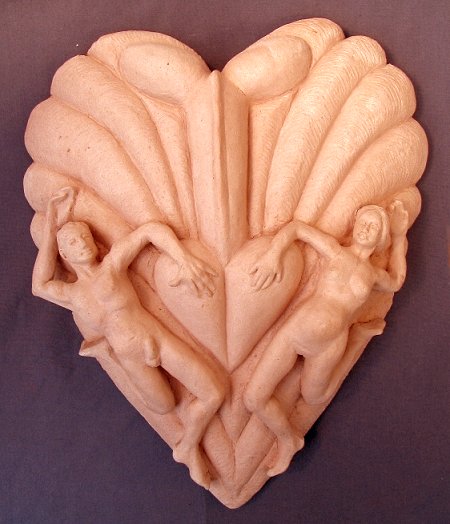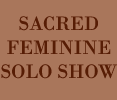
|
|
 |
About the Piece The idea for this piece came from the Egyptian Amulet of the Sam, or Amulet of the Sma. The Sma is a representation of the yoni and lingam in union. However, Wheel of Life Couple with Sma is clearly not erotic, even though it symbolizes sexual union. I was also intrigued to read in several accounts that the Arabic magic phrase "Open Sesame" is a derivative of the Egyptian word seshemu, or sexual intercourse. I was particularly struck with how the female portion of the Sma was in the shape of a heart. Ever since I read Gloria Steinem’s foreword to The Vagina Monologues (1998, p.xiv) I have seen the heart shape with new eyes: “the shape we call a heart—whose symmetry resembles the vulva far more than the asymmetry of the organ that shares its name—is probably a residual female genital symbol…watching little girls drawing hearts in their notebooks, even dotting their i’s with hearts, I wondered: Were they magnetized by this primordial shape because it was so like their own bodies?” Prior to my reeducation concerning the heart symbol, I had always felt embarrassed by it. Hearts seemed to me banal and the height of cutesy; too girly-girl for me. How could you be taken seriously if you drew hearts? Now, I feel proud when I see the symbol, and Valentine’s Day is for me a colorful celebration of my womanhood. Another symbol I have reclaimed in this piece is the misappropriated swastika, or wheel of life. I used the wheel of life symbol for several reasons, primarily because it is a powerful archetypal symbol, as is evidenced by its prevalence in many cultures. The swastika has been a religious emblem since 10,000 B.C.E. and has appeared in India, Japan, Asia Minor, Greece, China, Persia, Libya, Scandinavia, Britain, and Iceland, among other countries. I also use the swastika as a metaphor for how women, and many of their symbols, have been besmirched and robbed of their rich heritage. Barbara Walker writes in her The Woman’s Dictionary of Symbols and Sacred Objects (page 61) that the swastika is named from the Sanskrit “so be it,” or “amen,”. A swastika with arms pointing clockwise was generally regarded as a solar emblem. A counterclockwise one (sauvastika) represented the moon, night, and the feminine principle.
For questions or comments about Cydra's art, please email: womansculpture@icloud.com |


